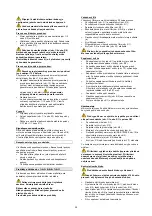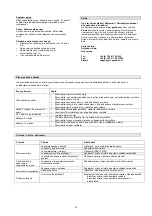
•
Pull slowly the starter cord (pic. 1/12 or 2/12) until
resistance can be felt, then pull strongly to start the
engine.
Do not let the starter cord to snap back.
Instead, hold it carefully with your hand.
•
As soon as the engine gets warm, put the choke lever
(pic. 1/13 or 2/13) back to the starting position.
Use:
The inverter generator must necessarily be connected to a
chassis ground (pic. 1/7 or 2/7) if the connected appliances
are grounded.
Connection to electrical equipment of a building is
inadmissible unless a disconnector is installed.
The given maximum input value must not be
exceeded in any connecting plug.
AC operation:
•
Start the engine and make sure the indicator (pic. 1/5 or
2/5) is green.
•
Make sure that the used appliance is switched off. If so,
plug the appliance to a three-phase outlet (pic. 1/3 or
2/3).
If the overload indicator (pic. 1/6 or 2/6) switches
on for a short time on a repeated basis, it may shorten
the appliance service life. If the indicator switches on
permanently, the generator may get damaged.
The overload indicator switches on if the rated power of
the given generator is exceeded.
DC operation:
The DC outlet may only be used to charge a 12 V
battery.
Under DC operation, the Eco throttle valve switch (pic. 12)
must be in the OFF position.
•
Connect the feeder cable with the DC outlet and battery
terminals (pic. 13). To prevent sparking, the feeder
cable must be first connected to the generator and then
the battery. To disconnect the feeder cable, release the
battery cables first.
If the generator is
connected to a battery, do not start the vehicle
engine.
•
Start the engine.
If the DC circuit is overloaded, the safety switch (pic.
1/10 or 2/10) jumps out. In such a case, wait for a few
minutes and then press the button inside and continue
in your work.
Switching off:
•
Switch the connected appliance off and unplug it.
•
Put the ignition switch (pic. 1/1 or 2/1) to the OFF
position.
•
Put the fuel tank cap ventilation lever to the OFF
position (pic. 1/1 or 2/1).
Lack of oil signalling:
Before the oil level drops too low, the engine switches
automatically off. The indicator (pic. 1/8 or 2/8) is red and
the engine is not running when the starter is put into action.
In such a case, check the oil level and add some.
Safety instructions for the operator
To put the appliance into operation for the first time, see the
General safety instructions, Appliance-specific safety
instructions and Safety instructions for first starting up.
•
Use the appliance only after careful reading of the
Operating Instructions.
•
Follow all safety instructions included in the Operating
Instructions.
•
Behave responsibly to other persons.
Inspections and servicing, pic. 1+2+3+4+5+6+7+9+11
Regular cleaning and servicing are necessary to provide perfect
working and long service life of the appliance.
Appliance adjustment to be only performed when the
appliance is unplugged. Significant risk of injury.
Do not smoke when performing the below-mentioned
works.
Never work near sparks, flames or open fire.
Regular servicing and inspections
Air filter
The air filter should be cleaned every 50 hours of operation.
•
Release the bolt (pic. 3/1) and remove the cover (pic. 3/2).
•
Release the air filter cover bolt (pic. 5/1).
•
Remove the air filter cover (pic. 5/2).
•
Check the external and main filter (pic. 5/3+4) and wash it
in non-flammable or little flammable solvent and let it dry
out if necessary.
•
Drop small amount of oil on the air filter and press it.
•
Refit the filter.
•
Fasten the air filter cover bolt (pic. 5/1).
•
Tighten the cover (pic. 3/2) and the cover bolt (pic. 3/1).
The appliance must never be used without the air
filter as it could quickly wear the engine out.
Spark plug
•
Remove the servicing cover off the spark plug (pic. 6/1).
•
Remove the socket plug (pic. 6/2).
•
Remove any dirt and dust off the bottom of the spark plug.
•
Using the spark plug spanner (pic. 7/1), screw the spark
plug out.
•
Check the spark plug for any cracks and scratches. If the
spark plug has any sign of damage, dispose it
immediately.
•
If the spark plug can still be used, clean it by a wire brush.
•
Now check the distance of electrodes by a feeler gauge.
Bend the side electrode and provide the proper distance
(proper distance: 0.6 to 0.7 mm).
•
Refit the spark plug.
•
Refit the socket plug (pic. 6/2) on the spark plug.
•
Refit the servicing cover (pic. 6/1).
Oil change
Engine oil to be discharged when the engine is warmed up to
make sure it is emptied quickly and to the full extent.
Before discharging, make sure the fuel tank cap
ventilation lever (pic. 1/1 or 2/1) is in the OFF position.
•
Release the cover bolt (pic. 3/1).
•
Remove the left cover (pic. 3/2).
•
Remove the oil tank cap (pic. 4/2).
•
Discharge the engine oil to an appropriate container (pic.
4)
•
Add the recommended engine oil (SAE 10W-30, pic. 10)
and check the engine oil level (pic. 4/3).
•
Fit the oil tank cap (pic. 4/2).
•
Refit the cover (pic. 3/2) and tighten the bolt (pic. 3/1).
After coming into contact with the waste oil, hands should be
thoroughly washed with water and soap.
Please observe the applicable environment protection
provisions when disposing the waste oil. We recommend
taking the waste oil to a waste oil collection centre in a
closed vessel. Do not put the engine oil to waste and do
not pour it on the ground.
16
















































